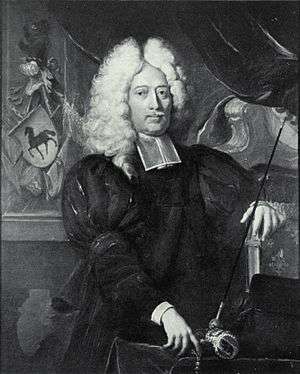Samuel Frisching (II)
Samuel Frisching (27 June 1638 – 23 October 1721) was a Bernese soldier and politician. Between 1715 and 1721 he served as that Free imperial city's "Schultheiss", a position not totally dissimilar from that of a modern city mayor.[1]
Samuel Frisching | |
|---|---|
 Samuel Frisching (1638–1721) painted by Johann Rudolf Huber | |
| Born | 27 June 1638 |
| Died | 23 October 1721 (aged 83) |
| Occupation | Soldier Politiian |
| Spouse(s) | Magdalena von Weiss (1647-) |
| Children | Y |
| Parent(s) | Samuel Frisching (1605-1683) Susanne Lombach |
Life
His parents' fourth son, Samuel Frisching came from a leading Bern family.[2] His father, also called Samuel Frisching, was a chief magistrate and himself the city's Schultheiss between 1668 and 1682.[2] The younger Samuel Frisching completed his schooling in Bern and then went on to study at Geneva between 1656 and 1657. It was while he was in Geneva that in 1658 the twenty year old joined the French Swiss Guard in defiance of his father's wishes.[1]
While a soldier he was seriously wounded in battle at Gravelines, narrowly avoiding being buried by a mine explosion [3] This was followed by an extended educational tour through England, Scotland, the Netherlands and Germany, after which he returned to Bern: in compliance with the family's wishes he now embarked on a career of service to his city.[1]
He became a member of Bern's Great Council in 1664, progressing to membership of the Inner Council in 1685. In this capacity he was entrusted with a succession of quasi-ambassadorial missions. In the meantime he had already served, in 1670, as Schultheiss in Burgdorf, a small town of qualified autonomy to which Bern had been entitled to appoint the Schultheiss since 1384. In 1715 he was appointed "Schultheiss" of Bern.
In parallel with his service in civic administration, Frisching also continued with his military career where opportunities arose. In 1712, by now aged 74 he was the General who took command of the Protestant confederate army in the Second War of Villmergen after the army commander Nicolas de Diesbach and his lieutenant Jean de Sacconay had both been badly wounded at Villmegen.[3] Frisching is credited with having turned an impending rout into a victory on 25 July 1712.[3]
Built legacy
Between 1705 and 1706 Frisching greatly extended his family home in the city's Junkerngasse, using plans supplied by the engineer-architect Joseph Abeille. The resulting "urban palace" is now known as the Béatrice-von-Wattenwyl-Haus,[1] an impressive south facing city mansion, sometimes used in our own age for civic functions.
A statue of Samuel Frisching is the fourth of the eight adorning the front upper level exterior of the Cantonal Bank main building in Bern.
Family
One of the sons of Samuel Frisching was Johann Frisching, a Swiss military officer and magistrate who married Susanna Margaretha Stürler of the Wattenwyl dynasty. Johann himself was a member of the Bern Great Council in 1701, and of the Inner Council in 1721.
A grandson, Rudolf Emanuel Frisching (1698-1780) was also an officer and a magistrate.
References
- Barbara Braun-Bucher (12 August 2003). "Frisching, Samuel". Historisches Lexikon der Schweiz, Bern. Retrieved 4 August 2015.
- Emil Blösch (1878). ADB "Frisching, Samuel" Check
|url=value (help). Allgemeine Deutsche Biographie (ADB). Duncker & Humblot, Leipzig. p. 95 f. - R de Steiger (1864). Samuel Frisching. Chefs des anciens armées ou levées Bernoises. Imprimerie R.-F. Haller. p. 31. Retrieved 4 August 2015.